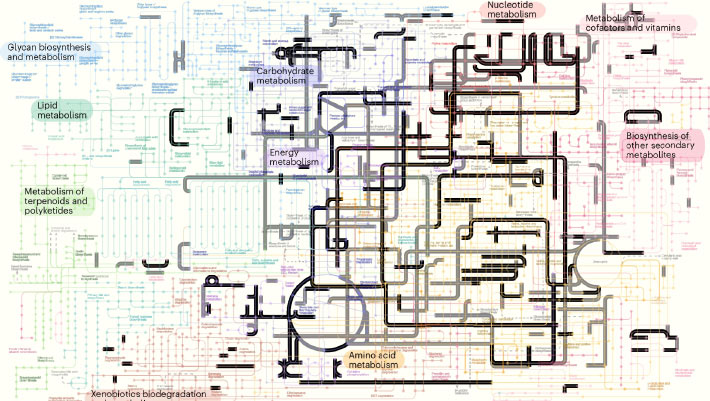The Last Universal Common Ancestor (LUCA) is a hypothetical common ancestor of all modern cellular life, from single-celled organisms such as bacteria to giant sequoia trees and even to us humans. Our understanding of LUCA therefore has implications for our understanding of the early evolution of life on Earth.
Probabilistic inference of metabolic networks for modern organisms present in LUCA. Image courtesy of Moody others., doi: 10.1038/s41559-024-02461-1.
LUCA is a node on the tree of life from which the basic prokaryotic domains (Archaea and Bacteria) branch off.
Modern life evolved from LUCA from a variety of different sources: the same amino acids used to build proteins in all cellular organisms, a shared energy currency (ATP), the presence of cellular machinery such as ribosomes involved in creating proteins from information stored in DNA, and even the fact that all cellular organisms use DNA itself as a way to store information.
In the new study, University of Bristol scientist Edmund Moody and his colleagues compared all the genes in the genomes of modern species and counted the mutations that had occurred in the sequences over time since a common ancestor called LUCA.
The time when some species split off is known from the fossil record, and the team used a genetic equivalent of a familiar equation used in physics to calculate speed to determine when LUCA existed, arriving at 4.2 billion years ago – just 400 million years after Earth and the solar system formed.
“The evolutionary history of genes is complicated by the exchange of genes between lineages,” Dr Moody said.
“Reconciling the evolutionary history of genes with species lineages requires the use of complex evolutionary models.”
“We didn’t expect LUCA to be so old, within just a few hundred million years of Earth’s formation,” said Dr Sandra Alvarez-Carretero, also from the University of Bristol.
“But our findings are consistent with modern views of the habitability of early Earth.”
The study authors also traced the lineage of life back to LUCA and modeled the physiological traits of modern species to elucidate LUCA’s biology.
“One of the real advantages here is that we applied the gene tree and species tree reconciliation approach to a highly diverse data set representing the major domains of life: Archaea and Bacteria,” said Dr Tom Williams from the University of Bristol.
“This allows us to make statements with some confidence about how LUCA lived and to assess that level of confidence.”
“Our study shows that LUCA was a complex organism not too different from modern prokaryotes, but what’s really interesting is that LUCA clearly had an early immune system, indicating that by 4.2 billion years ago our ancestors were in an arms race with viruses,” said Professor Davide Pisani, from the University of Bristol.
“LUCA clearly used and transformed its environment, but it is unlikely to have lived alone,” said researcher Dr Tim Lenton, from the University of Exeter.
“That waste would then serve as food for other microorganisms, such as methanogens, helping to create a recycling ecosystem.”
“The insights and methods provided by this study will also inform future studies looking in more detail at the subsequent evolution of prokaryotes in the context of Earth’s history, including the less-studied archaea and their methanogens,” said Professor Anja Spang, researcher at the Royal Netherlands Institute for Marine Research.
“Our study brings together data and methods from multiple disciplines, revealing insights into the early Earth and life that could not be achieved by any single discipline alone,” said Professor Philip Donoghue, from the University of Bristol.
“It also shows how quickly ecosystems were established on the early Earth.”
“This suggests that life may thrive in an Earth-like biosphere somewhere in the universe.”
This study paper Published in the journal today Natural Ecology and Evolution.
_____
ERR Moody othersThe nature of the last universal common ancestor and its impact on the early Earth system. Nat Ecol EvolPublished online July 12, 2024, doi: 10.1038/s41559-024-02461-1
This article is a version of a press release provided by the University of Bristol.


